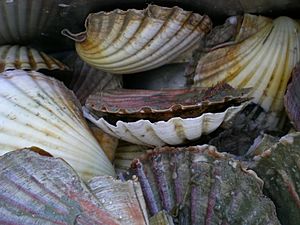New Zealand scallop facts for kids
Quick facts for kids New Zealand scallop |
|
|---|---|
 |
|
| A group of shells of Pecten novaezelandiae | |
| Scientific classification | |
| Genus: |
Pecten
|
| Species: |
novaezelandiae
|
Pecten novaezelandiae, also known as the New Zealand scallop, is a type of bivalve mollusc. It belongs to the Pectinidae family, which includes all scallops. Sometimes, its name is spelled a bit differently as Pecten novaezealandiae.
Contents
Where New Zealand Scallops Live
The New Zealand scallop is found only in New Zealand. This means it is endemic to New Zealand. You can find it around the North Island, South Island, Stewart Island, and the Chatham Islands.
Scallop Homes: Where They Live
New Zealand scallops live on the seafloor. They prefer sandy, silty, or muddy areas. You can find them from shallow waters near the shore to depths of over 90 meters. Many scallops live in waters that are 10 to 25 meters deep.
About the New Zealand Scallop
The New Zealand scallop can move freely. It is not stuck in one place. It can even travel short distances. Its two shells are not the same. One shell is curved outwards (convex). The other shell is flat. The curved shell has about 16 ridges.
The color of the shells can change. They are often a whitish pink. But sometimes, they can be a dark reddish-brown. Natural enemies of the scallop include sea stars and octopus.
Life Cycle of the New Zealand Scallop
Adult New Zealand scallops are hermaphrodites. This means each scallop has both male and female parts. They release their eggs and sperm into the water. This is called broadcast spawning.
The time when scallops spawn changes by location. In Tasman Bay / Te Tai-o-Aorere, they mostly spawn from November to March. After fertilization, a tiny planktonic larva forms. This larva floats in the water for about three weeks.
Then, the larva changes shape. This is called metamorphosis. It stops floating and attaches itself to the seafloor. It stays attached until it is at least five millimeters long. After that, it lets go and starts to grow into an adult scallop. Most scallops become adults by 18 months old.
New Zealand Scallop Fishing
The New Zealand scallop is very important for New Zealand's economy. It is a big industry and an export product. People usually eat the large white adductor muscle. Sometimes, the orange and white gonad is also eaten.
New Zealand scallops are seen as a special food. They can be quite expensive to buy. Both everyday people and commercial fishers can catch scallops. This is allowed during certain times of the year, called the scallop season.
There are rules about how many scallops can be caught. There are also rules about their size. This is part of a system to manage fishing. In some areas, like Tasman Bay / Te Tai-o-Aorere, young scallops (called spat) are placed on the seafloor. This helps make sure there are enough scallops for the future.
Images for kids


